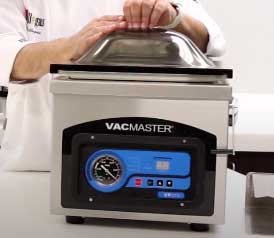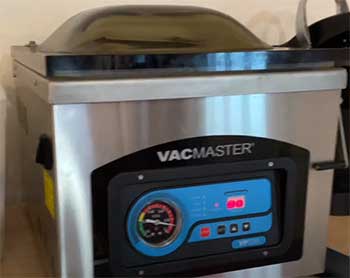Vacuum sealers are a must-have for hunters, fishers, DIYers, and anyone who wants to save money by buying in bulk or preserving their own food. Two of the most popular heavy duty models for home use are the VacMaster 215 and VacMaster 230.
But with similar features and price points, how do you choose between them?
I’ve taken an in-depth look at both VacMaster vacuum sealer models to highlight the key similarities and differences. Read on to find out which heavy duty vacuum sealer is the right fit for your food prep and preservation needs.
A Brief Comparison Table
| Feature | VacMaster 215 | VacMaster 230 |
| Chamber Size | 10″ x 20″ | 12″ x 26″ |
| Seal Bar Length | 12 inches | 16 inches |
| Suction Power | 27 Hg max | 27 Hg max |
| Cycle Time | 20-40 secs | 20-40 secs |
| Noise Level | Standard appliance noise | Standard appliance noise |
| Maintenance | Oil changes every 2-3 months | Oil changes every 2-3 months |
| Warranty | 3 years parts/labor, lifetime chamber | 3 years parts/labor, lifetime chamber |
| Voltage | 80-110V | 110-120V |
| Price | Around $500 | Around $650 |
Overview of The Vacmaster 215 And 230 Vacuum Sealers
The VacMaster 215 and 230 are both chamber vacuum sealing systems made for home use. They use a powerful pump to remove air from specially designed bags, then heat seals the bag shut. This extends food shelf life by protecting it from freezer burn, oxidation, and pests.
Both sealers are made in the USA by VacMaster. They have stainless steel chambers and commercial grade vacuum pumps. The main differences come down to size, sealing bar length, and price.
VacMaster 215

- 10″ x 20″ chamber
- 12″ seal bar
- 80-110 voltage
- Around $500 retail price
VacMaster 230
- 12″ x 26″ chamber
- 16″ seal bar
- 110-120 voltage
- Around $650 retail price
So the 230 model has a larger chamber and longer sealing bar. But it also costs about $150 more on average. Keep reading to see how the differences impact real world use.
Detailed Comparison of Features and Performance
Let’s take a deeper dive into how the VacMaster 215 and 230 models stack up in key categories:
Chamber Size
The chamber size determines what you can fit inside to vacuum seal.
- VacMaster 215: 10 inches wide x 20 inches deep
- VacMaster 230: 12 inches wide x 26 inches deep
Both chambers are tall enough to fit average sized bags of food. The 230’s extra width and depth give you more flexibility for sealing larger items. For example, you could vacuum seal an entire brisket or rib rack in the 230.
If you plan to seal a lot of big cuts of meat or fish, the VacMaster 230’s larger chamber is an advantage. But the 215 has ample space for most normal vacuum sealing tasks.
Seal Bar Length
The seal bar is the heating element that fuses bag layers together. A longer seal bar can seal bigger bags more efficiently.
- VacMaster 215: 12 inch seal bar
- VacMaster 230: 16 inch seal bar
Again, the 230 model’s extra length allows you to seal larger bags. Its 16 inch seal bar can vacuum seal a full width quart or gallon freezer bag.
The 215’s 12 inch bar length is sufficient for normal usage. But you may need to rotate or double seal wider bags to get a complete vacuum seal across the top.
Suction Power

Vacuum sealing food requires strong suction to remove all the air.
Both VacMasters use double piston pumps and have excellent vacuum strength.
Each model has variable speed settings up to 27Hg to vacuum seal efficiently without crushing delicate items.
The pumps are oil lubricated and built to last through consistent home use.
In terms of raw vacuum power, the 215 and 230 are on par with each other. Users report both units have enough suction to achieve quality seals every time.
Ease of Use
VacMaster designed both sealers to be easy to operate at home. They have digital control panels with simple buttons and indicator lights.
To vacuum seal food:
- Put item(s) in a bag and place in chamber.
- Close and latch the lid.
- Press the vacuum seal button.
- The machine will remove the air, then seal the bag shut.
The digital display shows vacuum progress and alerts you if anything needs attention. Detailed owner’s manuals provide operating instructions as well.
For the most part, both sealers are beginner-friendly. The 230 does have a slightly more complex control panel. But overall ease of use is comparable between the two models.
Cycle Times
How quickly can you get multiple bags sealed up? Cycle time measures the minutes it takes to fully vacuum seal each load.
The VacMaster 215 and 230 have similar cycle times in the 20-40 second range. Both operators report the units work efficiently for steady home meal prep and preservation.
Faster cycle times are handy for big sealing jobs like processing hunted game. But the VacMaster 215 and 230 are speedy enough for most household needs.
Noise Level
Vacuum sealing requires a constant pumping sound that can be loud in smaller home kitchens.
Users note both the 215 and 230 make noise comparable to a standard kitchen appliance. The vacuum pump hum is noticeable but shouldn’t disturb your household.
As expected, larger sealing loads take longer and make more noise. But in general, noise is reasonable for a heavy duty vacuum sealer.
Maintenance
Like most appliances, vacuum sealers require simple care to keep performing well. Key maintenance tasks include:
- Changing vacuum pump oil every 2-3 months
- Keeping sealing gaskets clean
- Removing any food debris after sealing
The VacMaster 215 and 230 have oil drains and removable gaskets for straightforward upkeep. Owners recommend following the maintenance schedule in the manual. This helps prevent oil contamination or valve issues down the line.
Both units are built for routine home use. With proper maintenance, the sealers deliver years of peak performance.
Warranty
VacMaster offers strong warranty coverage on both vacuum sealer models:
- 3 years – Parts and labor
- Lifetime – On vacuum chamber
This protects your investment against early manufacturer defects. Registering your warranty also gives you perks like discounts and product support.
The same generous warranty applies to the 215 and 230. A lifetime guarantee on the sealing chamber demonstrates VacMaster’s faith in their heavy duty design.
Voltage
Home voltage levels impact what sealer you can use:
- VacMaster 215: 80-110 volt
- VacMaster 230: 110-120 volt
The 215 plugs into standard household outlets. If your kitchen only has 120 volt power, the 230 is likely the better fit.
Always check your home voltage before buying a vacuum sealer. Getting one that matches your electrical system avoids the need for extra adapters.
Best Uses for Each Model
Now that we’ve compared the VacMaster 215 and 230 head to head, let’s discuss ideal usage cases.
VacMaster 215
The 215’s moderate size and price point make it a versatile sealer suitable for:
- Small households
- Hunters and fishers
- DIYers and crafters
- Freezing berries/veggies from the garden
- Marinating meat with a vacuum
- Sous vide cooking prep
It has enough power for most sealing tasks without taking up too much counter or storage space. The 215 suits casual users who still need serious vacuum strength.
VacMaster 230
With its extra large chamber and seal bar, the 230 excels at:
- Preserving big game and fish
- Seal cooking large cuts of meat
- Quickly sealing big batches or bulk purchases
- Vac packing odd shaped items
- Commercial-sized food prep and preservation
The expanded capacity gives you flexibility. Avid hunters, DIYers, and homesteaders will appreciate the 230’s heavy duty design. It’s built to keep up with vigorous household use.
Key Pros and Cons of VacMaster 215 And 230 Vacuum Sealers
To recap the main advantages and downsides of each vacuum sealer:
VacMaster 215
Pros:
- Compact 10″ x 20″ chamber
- Budget-friendly price
- 12″ seal bar handles average bags
- Easy to use and maintain
- Quiet operation
Cons:
- Smaller capacity than 230
- Shorter seal bar
VacMaster 230
Pros:
- Roomy 12″ x 26″ chamber
- Long 16″ seal bar for big bags
- More power for large sealing jobs
- Can vacuum seal entire briskets/rib racks
- Higher suction for fast cycle times
Cons:
- Significantly higher price tag
- Larger footprint
As you can see, there are good reasons to choose either the 215 or the 230 VacMaster model depending on your needs and budget.
The 230 costs more but offers greater size and strength. The 215 provides ample power for most in a smaller package. Select the one aligned with your usage requirements.
Frequently Asked Questions (FAQ)
Here are answers to some common questions about the VacMaster 215 and 230 vacuum food sealers:
The 215 VacMaster can seal up to 12 inch wide bags across its 12 inch seal bar. This allows you to vacuum seal standard gallon or quart freezer bags.
For larger bags, you may need to rotate the bag or double seal to fully evacuate the air. But the 215 can handle average vacuum sealing tasks.
VacMaster recommends changing the pump oil every 2-3 months for moderate use. If you’re vacuum sealing daily, monthly oil changes keep the pump functioning smoothly.
Be sure to only use pure vacuum pump oil to maintain suction power and prevent contamination.
Chamber sealers like the VacMaster units use stronger vacuum pressure and heat seal the entire bag at once. This makes them preferable for serious home use and big sealing jobs.
Suction sealers are more affordable and better suited for light, occasional sealing. Go with a chamber model if you want true heavy duty performance.
Yes, both VacMaster models can vacuum seal mylar bags. The chamber design holds up well for long-term food storage bags.
Be sure to use mylar bags designed specifically for vacuum sealing. Look for bags with textured channels so the air can fully evacuate.
Final Thoughts
After looking closely at the VacMaster 215 and VacMaster 230, a few key facts stand out:
- The 230 model has a larger chamber and longer seal bar to handle big bags and cuts of meat.
- The 215 sealer provides ample strength and space for average home use at a lower price.
- Both units have excellent vacuum power, cycle speeds, and easy maintenance.
For hunters, fishers, and serious DIYers sealing large batches, I recommend the VacMaster 230. The extra capacity makes it ideal for big jobs.
For smaller families or households, the 215 offers solid performance in a compact footprint. Casual users who still want true vacuum strength should consider the 215.
No matter which VacMaster sealer you choose, follow the maintenance schedule for years of quality sealing. And be sure to buy bags designed specifically for vacuum sealers.
With the ability to quickly seal food at peak freshness, a VacMaster chamber sealer is a smart investment for any home kitchen. Let me know if you have any other questions about choosing between these powerful vacuum sealers!

